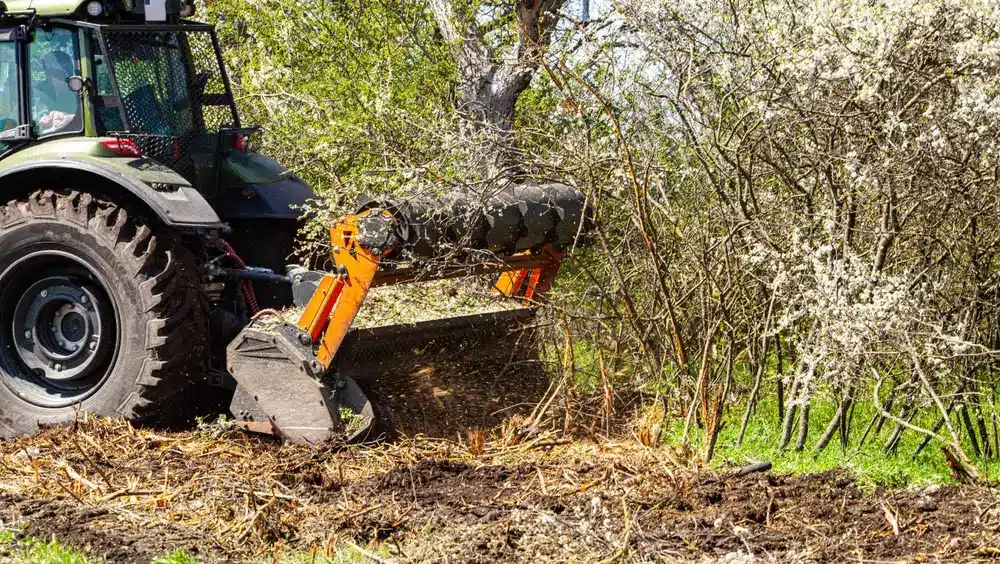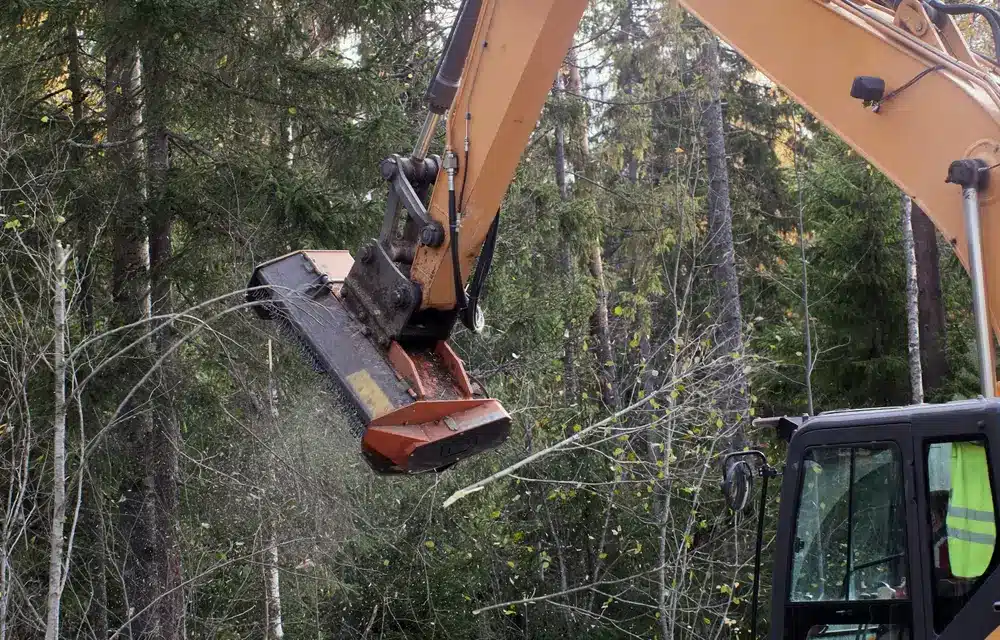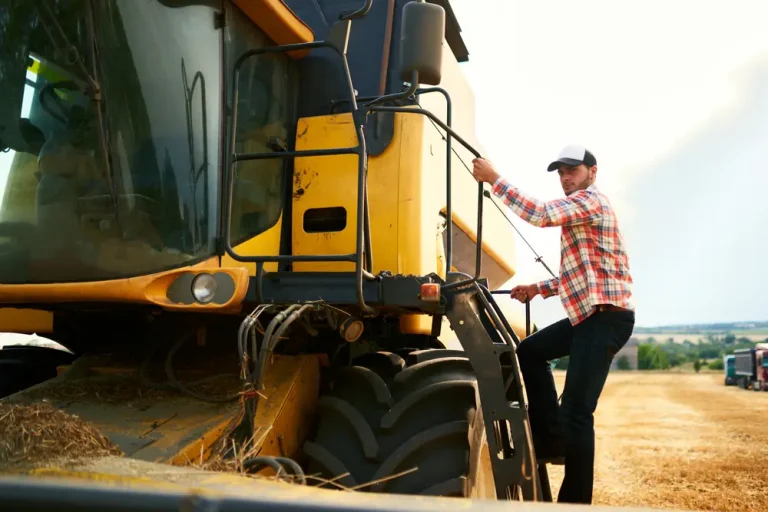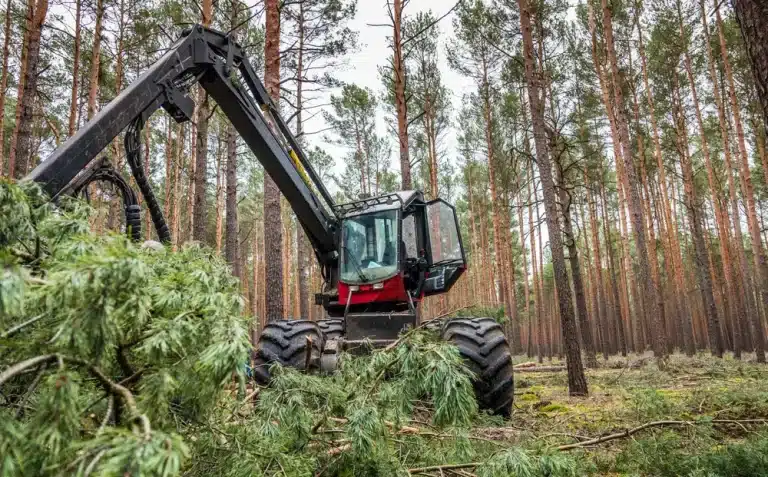Using a forestry mulcher on steep slopes, rocky ground, wetlands, or in disaster-damaged zones requires more than skill. It demands planning, adapted machines, and an understanding of terrain-specific risks.
Safety becomes critical where every inch of land can hide a mechanical hazard, and where vegetation density changes by the meter.
Whether clearing invasive plants in flood-prone zones or restoring land after a wildfire, operators need to respect both the machine’s limits and the land’s unpredictability.
The following guidelines provide structured advice for professionals working in extreme field conditions, whether using a skid steer or a spider excavator.
Evaluating site conditions before starting operations
Reading the ground and understanding terrain risks is the first and most essential layer of protection when operating a forestry mulcher in challenging conditions.
Every terrain has its own dangers, and misjudging them can have direct mechanical and human consequences. Slopes may seem mild but can hide instability under soft topsoil, while thick vegetation may obscure stumps or rocks that can cause blade damage or sudden jolts.
On larger plots or remote sites, overlooking these factors often leads to operational delays, breakdowns, or even injury. Mapping the area beforehand, ideally with a walk-through or aerial scan, helps anticipate resistance levels, identify potential blind spots, and evaluate how best to approach the terrain.
It is also a chance to estimate what vegetation the mulcher will face: dense underbrush, woody debris, or low-hanging branches each pose unique technical constraints.
By integrating terrain reading into pre-operation routines, teams reduce the chance of error and create a more fluid workflow.
A well-prepared operator reacts less and adjusts more proactively, which is especially crucial when each delay or mistake translates into real financial loss.
Soil types influence machine response
The type of soil has a direct impact on how the mulcher responds to weight, movement, and vibration. Soft, loose, or sandy soils may look harmless but often become traps for heavy machines, especially when the surface gives way under pressure.
In these zones, the risk of tilting or sinking increases, which can compromise both operator safety and machine stability.
On the other end of the spectrum, hard or rocky soils do not give way, but instead transfer intense vibration back to the machine. This creates stress on the mulcher head, coupling points, and chassis, especially if the blades strike stone repeatedly.
Excessive vibration can also accelerate fatigue in critical components and eventually cause structural damage. Operators must therefore adjust their behavior depending on soil resistance.
Did you know? Soil moisture can change within hours, especially after rainfall, turning a safe path into a trap for even the most advanced machines. Operators often re-scout the terrain after weather events to avoid misjudging soil firmness or traction.
Reducing operational speed, using a wider cutting path, or adjusting blade type can make a decisive difference.
Equipment balance becomes a tactical factor, particularly when transitioning from one soil type to another within the same site.
Failing to account for these conditions not only damages the machine but often results in incomplete work, forcing repeated visits and extra costs.
For fine-tuned settings on compact machinery, refer to how to optimize mulcher performance on skid steer machines to ensure optimal response on variable soil conditions.
Slope analysis prevents overturning
Inclines above 25 degrees require machines with a low center of gravity and superior traction, like spider excavators. Standard skid steers should not attempt steep work without attachments designed for balance and controlled tilt. Consider these strategies:
- Use track-mounted units for better traction on loose or inclined surfaces
- Reduce machine speed when descending to maintain control
- Avoid turning on steep gradients to minimize rollover risks
Vegetation signals terrain danger
Heavy vine growth, thick underbrush, or tree clusters may conceal logs, rocks, or holes.
By walking the path before starting, operators can mark hazards and anticipate blade strain. Vegetation type also impacts tool selection. Learn what types of vegetation a mulcher can handle and select your tool accordingly.
Preparing the right equipment for harsh environments

Challenging terrain demands more than basic operational skill. It requires forethought and deliberate customization of your machine setup.
Using a standard configuration across all types of ground increases risks and reduces productivity.
Whether you are clearing sloped forest paths, post-storm debris fields, or vegetation near rock faces, your mulching equipment must match the stress level of the environment. This includes not only the base machine but also the type of mulcher head, blade configuration, hydraulic settings, and impact protection.
A tailored approach ensures that the equipment performs reliably under strain and maintains output even when conditions change unexpectedly.
Ignoring these preparation steps often leads to breakdowns, unsafe working conditions, and delays that can compromise the entire operation timeline.
Equipment customization increases efficiency
Selecting the correct mulcher and adjusting its configuration to match the site is one of the most effective ways to boost performance while maintaining safety.
- A drum mulcher, with its deeper bite and rotational power, is ideal for areas with thick undergrowth, fallen trunks, and tightly packed woody material. It can break down stumps and heavy limbs without frequent stalling.
- In contrast, flail mulchers are more suitable for grassy zones or terrain that undulates sharply, thanks to their flexibility and better surface adaptation. They create finer mulch, which is useful in agricultural or reforestation applications.
In environments marked by past disasters such as wildfires, landslides, or storms, where hidden objects like nails, rebar, or wire mesh are often buried under debris, using reinforced blades becomes essential. Protective components like heavy-duty skid plates or engine armor shields help the machine absorb impacts without sustaining costly internal damage.
Adjusting the tool before the job starts allows the operator to focus fully on control and progress without compensating for inefficiencies mid-operation.
Operator protection is non-negotiable
In harsh environments, the safety of the operator is never an afterthought. It is the central condition that allows any mulching operation to take place efficiently and without incident.
A forestry mulcher, especially in unstable or high-resistance terrain, can turn even a small error into a major hazard. Also, never skip your maintenance schedule.
When vegetation density increases or the land becomes steep, the risk of flying debris, sudden machine shifts, or mechanical failure also rises.
That is why protecting the person in control of the machine is not just about compliance, it is about operational continuity.
“A mulcher is only as safe as the person operating it, and their ability to read the terrain.”
— Lead Safety Trainer, Wildland Operations Northwest
Whether you are managing wild slopes, disaster-damaged zones, or brushland on fire-prone ground, having the right protection in place can make the difference between a safe day and an avoidable accident.
For machines without cabs, personal protective equipment becomes crucial, including:
- Full-face shield with side protection
- Forestry-grade boots with ankle support and puncture resistance
- Fire-retardant suit if working in dry or fire-prone zones
Backup tools ensure site safety and operational fluidity
Equipping the job site with secondary manual tools is a simple but often neglected measure.
When terrain becomes too narrow, blocked, or steep for the mulcher to pass safely, operators must rely on handheld support.
Chainsaws, shovels, jacks, and wedges allow for clearing small but critical obstructions without stressing the main equipment.
These tools also allow teams to react rapidly in case of machine failure or environmental instability, like a rockslide or falling limb. Transporting these items as part of your standard loadout improves responsiveness and reduces delays.
Knowing how to use them properly is part of team training, which should include first-aid, evacuation protocols, and basic troubleshooting.
Operating with visibility and environmental awareness
Using a forestry mulcher in uneven terrain without proper visibility and environmental sensitivity can quickly escalate into operational hazards. Steep slopes, tree shadows, uneven light conditions, and proximity to watercourses or rock formations reduce visual control and limit spatial awareness.
Accidents often result from blind spots, missed obstacles, or unplanned equipment movements. In parallel, careless driving or aggressive cutting patterns can harm delicate ecosystems. This includes compacting wet soils, disturbing animal habitats, or damaging regrowth areas.
A safety-focused operator must not only manage the machine but also integrate terrain reading, vegetation types, and local regulations into the workflow. This approach reduces liability and improves results, especially in public contracts or environmentally restricted zones.
To work safely on hills and uneven ground, understand mulcher attachments for spider excavator.
Maintain a wide field of vision
Clear sightlines are critical when operating heavy mulching equipment in areas where slope gradients shift or where visibility is obstructed by trees, rocks, or brush piles.
Machines with limited rear vision or low cabins increase blind spots, especially on uneven paths. To maintain situational control, use mirrors adjusted for full side coverage and cameras if available.
For larger or multi-day projects, assign a ground spotter with a clear radio connection to guide tight maneuvers or alert the operator to unseen obstacles.
Additionally:
- Clear a perimeter of at least 3 to 5 meters around your operation zone before starting
- Reassess the environment regularly, especially when entering a new zone or cutting through heavy clusters
- Use high-visibility paint or markers to highlight drop-offs, tree stumps, or water edges
These practices support operational stability, especially when terrain conditions evolve throughout the day due to weather or shifting debris.
Respect ecological boundaries

Forestry mulching is often used in zones that overlap with sensitive environments, such as wetlands, dry scrublands, or forest restoration plots. These landscapes may serve as buffer zones, wildlife corridors, or carbon sinks, meaning that a single misuse can have large environmental repercussions. Operating without consideration of ecological boundaries can lead to penalties, erosion, or irreversible habitat disruption.
To mitigate such risks:
- Use light-pressure machines like spider excavators on wetlands and peat-rich soils
- Avoid cutting regrowth areas unless specifically planned in the project scope
- Identify zones with protected species, nesting areas, or soil conservation plans in advance
These strategies align with the broader goals outlined in our article on the role of mulchers in sustainable land management, which emphasizes responsible clearing in both industrial and conservation projects.
Adjust pace and pattern to terrain
Speed is often the enemy of safety in mulching operations. When pressure mounts to clear large areas quickly, operators tend to increase pace or make repeated passes, which may seem productive but often reduces control. This is especially dangerous on steep terrain, where sudden shifts in balance or traction can destabilize the machine.
The right approach is to slow down and adjust your pattern based on slope direction, soil firmness, and vegetation resistance.
For instance:
- Mulch uphill at reduced speed to maintain front control
- Cross ridges with diagonal passes rather than direct downward runs
- Reduce machine load when operating near waterbanks or erosion-prone slopes
These terrain-specific adjustments are further detailed in our skid steer mulchers and spider excavator mulchers comparison, which outlines tactical differences in handling and stability.
Maintaining tools to reduce risks mid-operation
Forestry mulchers are exposed to intense strain in rough terrain, and their performance depends heavily on how well they are maintained.
In remote or unstable zones, even a minor defect can become critical.
Hydraulic pressure, impact vibration, and heat exposure all compound the wear rate. Regular upkeep is not just about protecting your equipment, it is about ensuring the safety of the operator and the surrounding environment.
When working on steep slopes, uneven ground, or dense vegetation, even a small mechanical failure can lead to accidents, delays, or fire hazards.
That is why maintenance is not optional, especially for professionals managing repetitive clearing or high-risk zones.
It is part of a broader risk mitigation strategy that aligns with sustainable land use and responsible operation.
A poorly maintained mulcher becomes a safety hazard in difficult terrain. Wear, tear, or hydraulic failures can escalate in high-resistance zones. Scheduled checks reduce surprise breakdowns and keep efficiency stable under pressure.
Regular inspection of wear components
Components like cutting teeth, rotor blades, drive belts, and mechanical couplings take the brunt of the work in rugged terrain. These parts are particularly vulnerable in areas with frequent contact with rock, thick roots, or woody debris. When mulching on slopes or in dry forest edges, dull blades can cause inefficiency, overheating, or excessive vibration that destabilizes the machine. A visual and manual inspection before and after each operation is crucial. Watch for signs like:
- Reduced cutting performance, which may indicate dull or cracked teeth
- Unusual noises or vibration, which often point to unbalanced rotors
- Loose belts or fasteners, which can detach during operation
If any of these signs appear, stop immediately and perform a detailed check. Continuing operation under stress can cause long-term mechanical damage.
For a full checklist and service intervals, refer to our article on how to maintain your forestry mulcher for long-term performance.
Clean systems avoid overheating and fire
Heavy vegetation clearing often means long hours, dense debris, and intense engine loads. In hot, dry conditions or post-fire zones, machines are particularly exposed to thermal buildup. Dust, leaf matter, and sap can accumulate around the engine compartment, leading to clogged filters and overheating. When hydraulic fluid or fuel lines get too hot, ignition risks increase dramatically. This is especially true near pine woods or underbrush containing volatile oils.
To prevent emergencies:
- Clean air filters and hydraulic vents after each use
- Wipe down the engine area to remove plant residue or oily buildup
- Carry a fire extinguisher that meets local fire code standards
This is not just a precaution but a necessity when working in wildfire-prone environments. Routine cleaning can lower machine temperature, reduce friction wear, and ensure consistent performance on challenging terrain.
Schedule maintenance based on terrain intensity
Maintenance frequency should never be based on calendar weeks alone.
A mulcher used on flat grassy fields for parkland maintenance wears differently from one operating daily on rocky mountain slopes or near wetlands.
Soil type, gradient, vegetation density, and operating hours all contribute to accelerated wear. You need a custom maintenance rhythm that matches your conditions.
For example:
- Soft terrain with minimal debris: monthly checks may suffice
- Slopes with boulders and stumps: weekly inspections recommended
- Emergency cleanup or disaster zones: daily post-operation review
If your operation includes both light and heavy terrain, split your maintenance schedule accordingly. A professional assessment can help you identify the most cost-efficient plan while preserving machine lifespan. Use our free quote form or get in touch via the contact page to define a service plan adapted to your project scale and terrain type.



